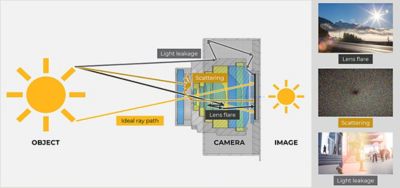-
United States -
United Kingdom -
India -
France -
Deutschland -
Italia -
日本 -
대한민국 -
中国 -
台灣
-
Ansys is committed to setting today's students up for success, by providing free simulation engineering software to students.
-
Ansys is committed to setting today's students up for success, by providing free simulation engineering software to students.
-
Ansys is committed to setting today's students up for success, by providing free simulation engineering software to students.
-
Contact Us -
Careers -
Students and Academic -
For United States and Canada
+1 844.462.6797
TOPIC DETAILS
What is Stray Light?
Stray light is the unintended, unwanted light that interferes with sensors in an optical system. Think of the sunbursts that speckle outdoor photos or the extra set of floating candles that appear in birthday cake videos. Any unplanned light that reaches the final image is considered stray light, and it can affect systems in a variety of applications such as augmented reality (AR), advanced driver-assistance systems (ADAS), microscopic research, and space-based imaging.
Types of Stray Light
Stray light is caused by external light sources entering the system and interacting with interior components. There are several types of stray light, defined by how the light breach manifests within the optical system.
Lens flare: Due to internal reflection into the system, lens flare can appear as streaks or bright orbs on an image. It is common in scenarios when the lens is pointed towards a bright light. Lens flare can be problematic in driver-assistance systems, in which accurate object detection depends on the analysis of many cameras at once.

Light leakage: Gaps and openings in the optical system can allow light to enter places where it’s not designed to be. This light can come from external sources or from within the system, and it can reduce contrast and create image artifacts. Light leakage is common in LCD monitors and device displays when frames do not fit tightly.

Scattering: When light interacts with particles, surface irregularities, or mechanical components, it can disperse in multiple directions, causing the final image to be hazy. In devices where multiple mirrors are part of the optical system, such as telescopes and satellites, any imperfection in the reflecting surface can create scattering effect, resulting in artifacts and noise on the final image.

Ghosting: Ghost images are a specific outcome of scattering that occurs when light bounces between optical elements, causing reflections that create a faint duplication of the primary image. In medical applications such as X-rays, ghost images can affect measurement accuracy and the reliability of diagnostics.
Veiling glare: Also known as flare, veiling glare refers to the loss of contrast that occurs on an image if the light source is extended, masking details. It can appear as circles or streaks and often overlaps bright objects in the image. In industrial environments, where robotics systems perform tasks based on what they “see,” veiling glare can obscure perception.


Sources and forms of stray light
Examples of Stray Light by Industry
Stray light impacts the performance and accuracy of optical systems by degrading image quality. It can create false artifacts, distort colors, affect measurements, and obscure environmental details. Across industries, stray light analysis and management is critical to avoiding issues that can impact safety, accuracy, and efficiency.
Automotive safety: Advanced driver-assistance systems (ADAS) rely on multiple cameras constantly monitoring the environment around a vehicle. Stray light can impede how these cameras see and analyze visual information, which can prevent object detection from working properly.
Aerospace perception: Stray light from the Sun and other stars can enter telescopes and satellites, diminishing the accuracy of their data collection and compromising mission objectives. Pilots using heads-up displays (HUD) to navigate can also be impacted, as glare due to stray light can decrease the readability of vital information in their line of sight.
Medical accuracy: In medical imaging devices such as MRI scanners, X-ray machines, dermatoscopes, and laser eye-surgery systems, stray light can create artifacts, poor image contrast, and distortions that compromise accurate diagnosis and successful treatment.
AR/VR experiences: Seamless immersion is what makes the digital realities so engaging. When stray light enters an augmented reality (AR) or virtual reality (VR) optical system, it disrupts the fictional environment and negatively affects the user experience.
To avoid these issues, engineers must be able to 1) identify the source of stray light, 2) analyze why it’s happening, and 3) choose the right design options to remediate the issue. Possible options for managing stray light include using baffles or light traps to block or absorb unwanted light, applying anti-reflection coatings and materials on optical surfaces, and adding shields and shades to the lens to prevent light entry.
How is Stray Light Analyzed?
Historically, stray light analysis required a physical prototype. This meant stray light could only be measured at the end of the process, when it was too late to modify the product design. Tools such as monochromators and spectroradiometers helped engineers understand stray light, but at the expense and delay of building the entire device. Today, engineers rely on optics simulation software to model optical systems and proactively address stray light implications, long before a physical prototype is constructed.
Stray Light Analysis and Simulation Software
Optical and Opto-mechanical Design Software: Used to model the entire optical system, including mechanical components such as mirror mounts, housing brackets, apertures, and lens barrels. It enables engineers to evaluate the system in different scenarios and conditions.
Ray Tracing Software: Used to simulate light rays as they travel through an optical system. Ray tracing software helps engineers analyze the impact of light on image quality, especially in complex and remote systems.
Image Analysis Software: Used to analyze images produced by optical systems. This software can help identify artifacts created by stray light and assess image quality and authenticity.
Simulation software helps engineers minimize stray light contamination in their system designs. By understanding the source, behavior, and impact of stray light, they’re able to optimize performance and avoid potential issues. These proactive explorations into how light moves will continue to provide new insights, and accelerate innovation in optical techniques, systems, and applications.
Related Resources
Let’s Get Started
If you're facing engineering challenges, our team is here to assist. With a wealth of experience and a commitment to innovation, we invite you to reach out to us. Let's collaborate to turn your engineering obstacles into opportunities for growth and success. Contact us today to start the conversation.











